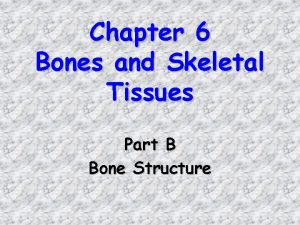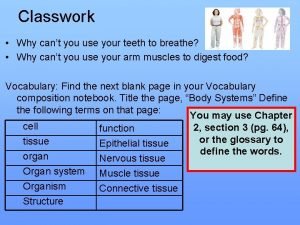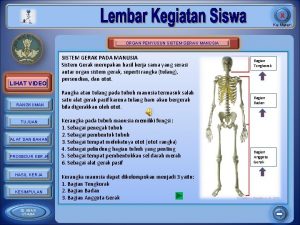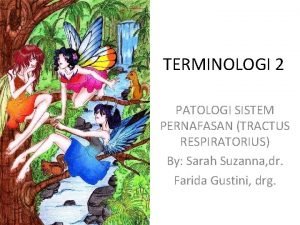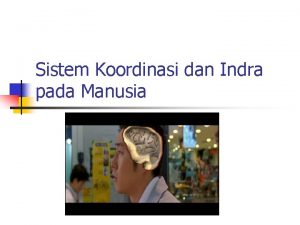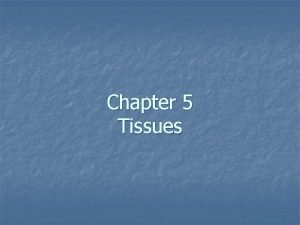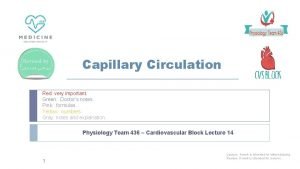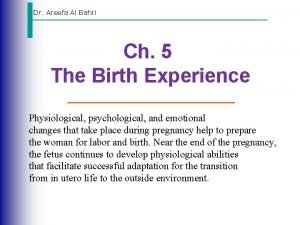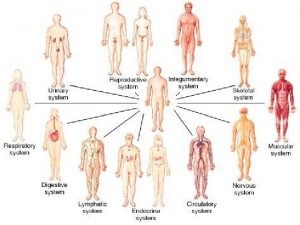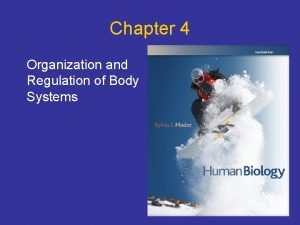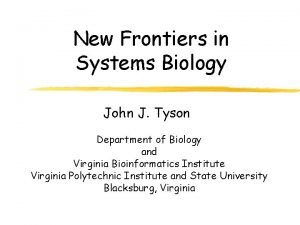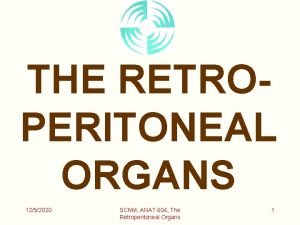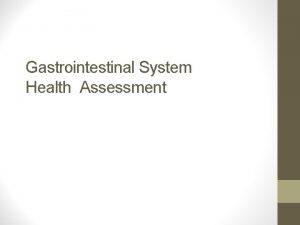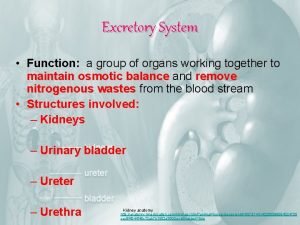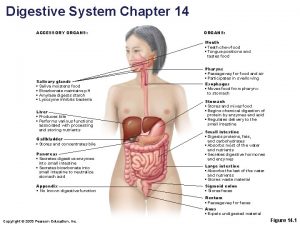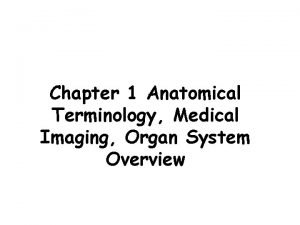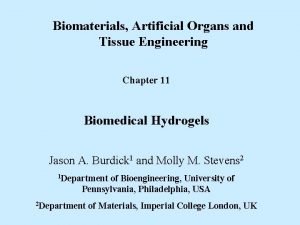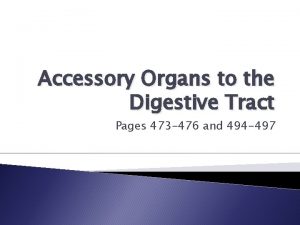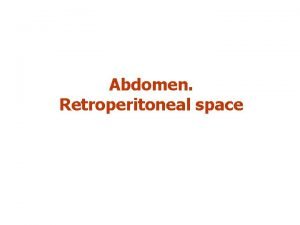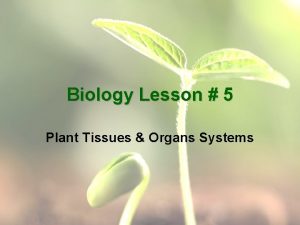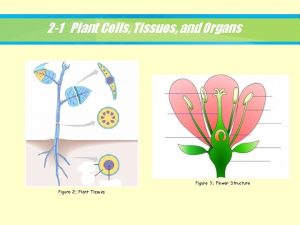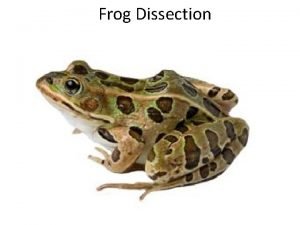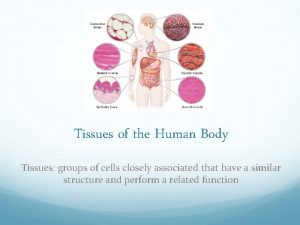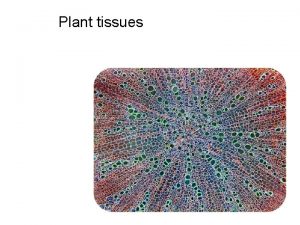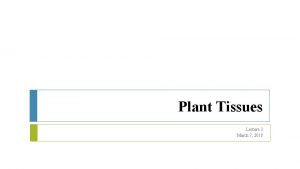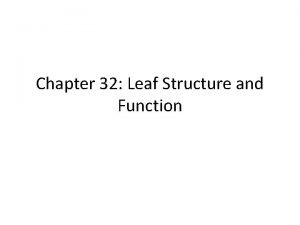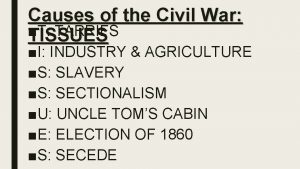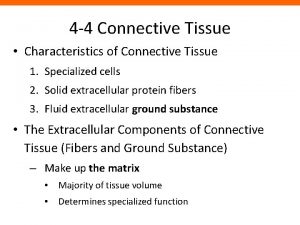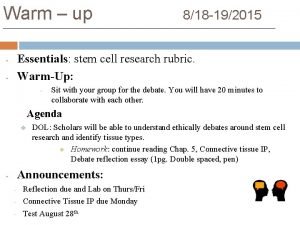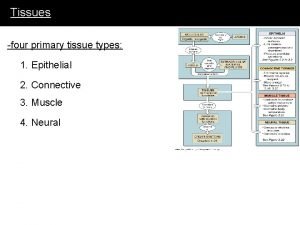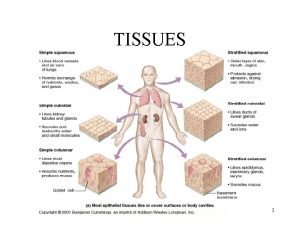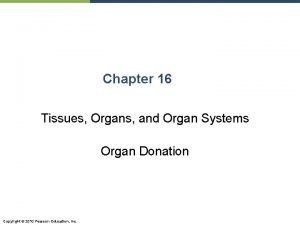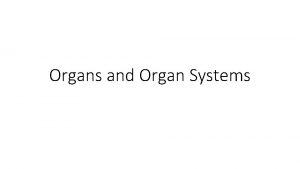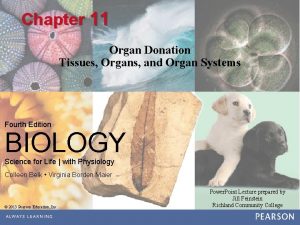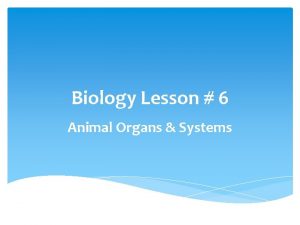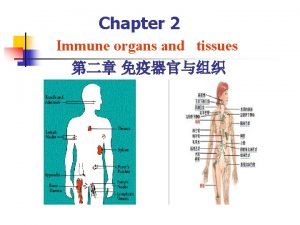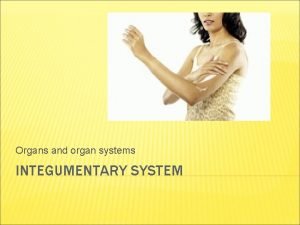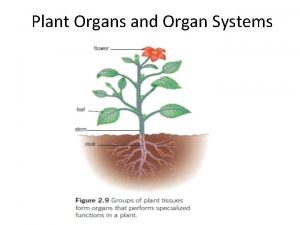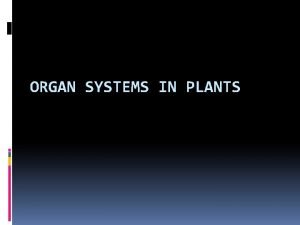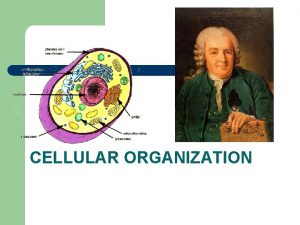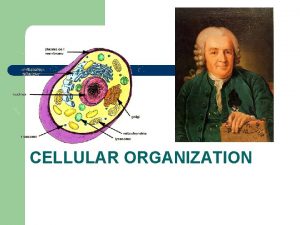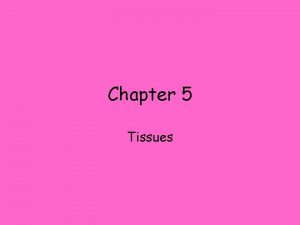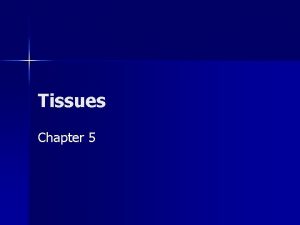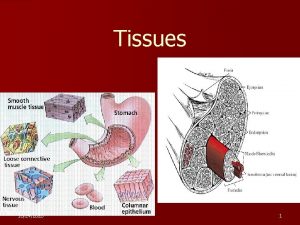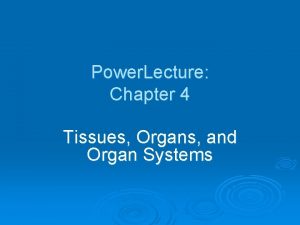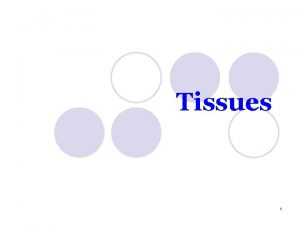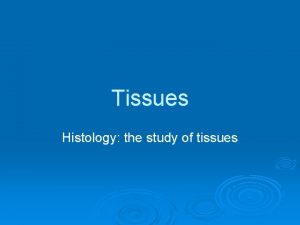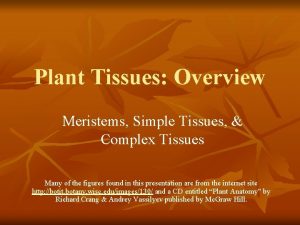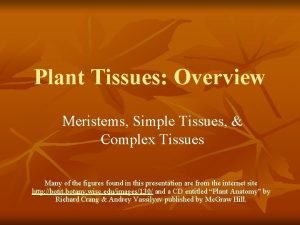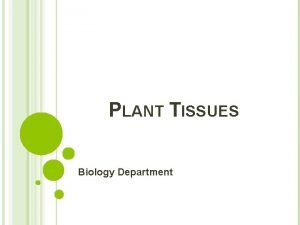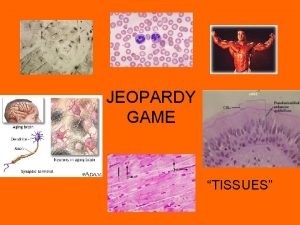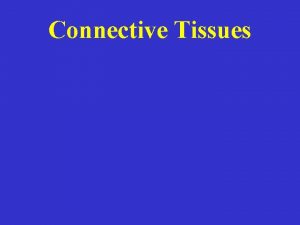Chapter 16 Tissues Organs and Organ Systems Organ



















































- Slides: 51

Chapter 16 Tissues, Organs, and Organ Systems Organ Donation Copyright © 2010 Pearson Education, Inc.

Chapter 16 Section 1 Tissues Copyright © 2010 Pearson Education, Inc.

16. 1 Tissues Levels of organization: § § § Cells Tissues Organ Systems Organisms Smallest Largest Tissues = group of similar cell types that perform a common function. Copyright © 2010 Pearson Education, Inc.

16. 1 Tissues = group of similar cell types that perform a common function. Four basic types of tissue: 1. 2. 3. 4. Epithelial Connective Muscle Nervous Copyright © 2010 Pearson Education, Inc.

16. 1 Tissues - Epithelial Tissue Epithelium is tightly packed sheets of cells § cover organs and outer surfaces § line insides of hollow organs, vessels, and body cavities. Copyright © 2010 Pearson Education, Inc. (a) Examples of organs lined with epithelial (b) Epithelial cells in skin tissue: Heart and blood vessels Epidermis Respiratory tract Digestive tract Urogenital tract (c) Epithelial cells lining the small intestine Figure 16. 1

16. 1 Tissues - Epithelial Tissue Epithelia are polar § anchored on one surface, but free on another § The free side is typically exposed to the environment or body fluids § Can be single layer or many layers thick § Function in protection, secretion, and absorption § Epithelial cells are continuously sloughing off and are replaced by cell division Copyright © 2010 Pearson Education, Inc.

16. 1 Tissues - Connective Tissue § Loosely organized and composed of cells embedded in a matrix § Cells § Examples include: Blood cells, adipocytes, fibroblasts, chondrocytes, osteocytes § Matrix is composed of two things 1. Ground substance § May be liquid, gel-like, rubbery or solid 2. Fibers § Collagen, elastin, reticular fibers Copyright © 2010 Pearson Education, Inc.

16. 1 Tissues - Connective Tissue § Usually binds organs or tissues to one another § Six different types: 1. 2. 3. 4. 5. 6. Loose connective tissue Adipose tissue Blood Fibrous connective tissue Cartilage Bone Copyright © 2010 Pearson Education, Inc.

16. 1 Tissues - Connective Tissue Loose Connective Tissue § Most widespread tissue in animal body § Matrix composed of collagen and elastin fibers § Cells are fibroblasts and adipocytes § It is called “loose” because fibers are loosely woven together § Binds epithelia to tissues, pads skin, and holds organs in place Copyright © 2010 Pearson Education, Inc. Figure 16. 2 a

16. 1 Tissues - Connective Tissue Adipose Tissue § AKA Fat § Primarily adipocytes; small amount of matrix § Functions § Used for storage of energy (fat) § Insulation § Padding for organs Copyright © 2010 Pearson Education, Inc. Figure 16. 2 b

16. 1 Tissues - Connective Tissue Blood § Cellular component § red blood cells, white blood cells and platelets § Matrix is the plasma § Functions include carrying oxygen and nutrients; fighting infection Copyright © 2010 Pearson Education, Inc. (c) Blood Platelet Red blood cell Plasma White blood cell Figure 16. 2 c

16. 1 Tissues - Connective Tissue Fibrous Connective Tissue § Forms tendons and ligaments § Matrix is collagen fibers running in parallel § Cells are fibroblasts Copyright © 2010 Pearson Education, Inc. (d) Fibrous connective tissue (tendon) Fibroblast cell Parallel collagen fibers Figure 16. 2 d

16. 1 Tissues - Connective Tissue Cartilage § Cells are chondrocytes § Cells secrete rubbery matrix, collagen and elastin § Cartilage cushions joints, forms support for ears and nose § Not vascularized, so takes a long time to heal if (e) Cartilage (at the end of a bone) Chondrocytes Matrix injured Copyright © 2010 Pearson Education, Inc. Figure 16. 2 e

16. 1 Tissues - Connective Tissue Bone § Rigid connective tissue § Cells are osteocytes § Cells secrete matrix of collagen fibers and calcium salts § Bone marrow produces blood cells § Body can make use of calcium from bones if dietary levels are too low Copyright © 2010 Pearson Education, Inc. (f) Bone Central canal Matrix Osteocytes Figure 16. 2 f

16. 1 Tissues - Muscle Tissue Muscle is contractile tissue § Long, thin cylindrical cells called muscle fibers § Two proteins – actin and myosin – interact to cause contraction of muscle fibers Three types of muscle: 1. Skeletal 2. Cardiac 3. Smooth Copyright © 2010 Pearson Education, Inc.

16. 1 Tissues - Muscle Tissue Skeletal Muscle § § Usually attached to bone Produces all voluntary movements Striated – due to overlap of actin & myosin Long, thin, cylindrical shape (a) Skeletal muscle (biceps) Muscle fiber Nucleus Copyright © 2010 Pearson Education, Inc. Figure 16. 3 a

16. 1 Tissues - Muscle Tissue Cardiac Muscle § Only found in heart tissue § Striated § Involuntary, undergoes rhythmic contractions to produce heartbeat § Branched, interlocking cells propagate signal to contract almost simultaneously (b) Cardiac muscle (heart) Muscle fiber Copyright © 2010 Pearson Education, Inc. Nucleus Figure 16. 3 b

16. 1 Tissues - Muscle Tissue Smooth Muscle § Not striated § Spindle-shaped cells § Musculature of organs, blood vessels, digestive tract § Involuntary § Contracts more slowly and for longer than skeletal muscle (c) Smooth muscle (intestine) Muscle fiber Copyright © 2010 Pearson Education, Inc. Nucleus Figure 16. 3 c

16. 1 Tissues - Nervous Tissue § Neurons conduct electrical signals § Primary cells of the brain and spinal cord § Main function of neurons is to: § Sense stimuli § Process stimuli § Transmit signals § Most cells of nervous system do not undergo cell division Copyright © 2010 Pearson Education, Inc.

16. 1 Tissues - Tissue Donation Brain death and Tissue Donation § Injuries from motor vehicle accidents, burst blood vessels, and drowning are common causes of brain death § Once dead, brain cells cannot recover § Other tissues can be harvested to help others § > One person’s tissues can improve the lives of as many as 50 people. Copyright © 2010 Pearson Education, Inc.

End Chapter 16 Section 1 Tissues Copyright © 2010 Pearson Education, Inc.

Chapter 16 Section 2 Part 1 Organs and Organ Systems Copyright © 2010 Pearson Education, Inc.

16. 2 Organs and Organ Systems § Organs are composed of two or more tissue types § Organs that act together form an organ system § All the organ systems of a body form an organism Copyright © 2010 Pearson Education, Inc. Muscle cell Muscle tissue Heart organ Circulatory system Organism Figure 16. 5

16. 2 Organs and Organ Systems 12 Organ Systems Copyright © 2010 Pearson Education, Inc. Figure 16. 8

16. 2 Organs and Organ Systems – The Liver as a Model Organ § The liver sits below the diaphragm § comprised of four lobes § associated with the gall bladder. Copyright © 2010 Pearson Education, Inc. Figure 16. 6

16. 2 Organs and Organ Systems The Liver as a Model Organ § The liver is an important component of the circulatory and the digestive system. § As part of the circulatory system, the liver: § Synthesizes blood clotting factors § Removes and breaks down toxins § Regulates blood volume § Destroys old red blood cells § As part of the digestive system, the liver: § Metabolizes and stores nutrients § Produces bile Copyright © 2010 Pearson Education, Inc.

16. 2 Organs and Organ Systems Liver Structure § Epithelia § Hepatocytes § Lining blood vessels § Lining bile ducts § Connective Tissue § Loose connective tissue § Kupffer cells Copyright © 2010 Pearson Education, Inc.

16. 2 Organs and Organ Systems - The Liver as a Model Organ Liver transplants can be made from living donors or from brain dead ones § Unlike many organs, liver can regenerate itself § Portion can be taken from living donor and implanted in patient § Liver in donor and patient will regrow to normal size Copyright © 2010 Pearson Education, Inc.

End Chapter 16 Section 2 Part 1 Organs and Organ Systems Copyright © 2010 Pearson Education, Inc.

Chapter 16 Section 2 Part 2 The Digestive System Copyright © 2010 Pearson Education, Inc.

16. 2 Organs and Organ Systems The Digestive System Alimentary canal 1 Mouth • Teeth reduce the size of food, increasing surface area available for digestion by enzymes. • Enzymes in saliva then start breaking down carbohydrates. Accessory organs of the digestive system Liver • Produces bile which aids absorption of fats Gall bladder • Stores bile and empties into small intestine Pancreas • Produces digestive enzymes • Produces a buffer that neutralizes acidity of stomach acid 2 Pharynx • Epiglottis blocks the opening to the windpipe when we swallow, so that our food goes into our esophagus rather than our lungs. 3 Esophagus • The esophagus transports food to stomach by rhythmic waves of muscle contractions called peristalsis. 4 Stomach • Acidic gastric juices start breaking down foods. • The enzyme pepsin breaks down proteins. • Mucous prevents gastric juices from digesting stomach. • Pyloric sphincter regulates movement of food from stomach to small intestine. 5 Small intestine • Most digestion of carbohydrates, proteins, and fats occurs here. • Nutrients are absorbed into the bloodstream. 6 Large intestine • Water is reabsorbed. 7 Anus • Undigested materials are excreted as feces. Copyright © 2010 Pearson Education, Inc. Figure 16. 8

16. 2 Organs and Organ Systems The Digestive System Mouth • Teeth reduce the size of food, increasing surface area available for digestion by enzymes. • Amylase enzymes in saliva start breaking down carbohydrates. Copyright © 2010 Pearson Education, Inc. Figure 16. 8

16. 2 Organs and Organ Systems The Digestive System Esophagus • The esophagus transports food to stomach by rhythmic waves of muscle contractions called peristalsis. Copyright © 2010 Pearson Education, Inc. Figure 16. 8

16. 2 Organs and Organ Systems The Digestive System Stomach • HCl starts breaking down foods. • The enzyme pepsin breaks down proteins. • Mucous prevents gastric juices from digesting stomach. • Pyloric sphincter regulates movement of food from stomach to small intestine. Copyright © 2010 Pearson Education, Inc. Figure 16. 8

16. 2 Organs and Organ Systems The Digestive System Small intestine • Most digestion of carbohydrates, proteins, and fats occurs here. • Nutrients are absorbed into the bloodstream. Large intestine • Water is reabsorbed Copyright © 2010 Pearson Education, Inc. Figure 16. 8

16. 2 Organs and Organ Systems - The Digestive System Internal Specializations § Mucosal folds, villi and microvilli increase the surface area of the intestines to allow nutrient absorption Copyright © 2010 Pearson Education, Inc. Figure 16. 9

16. 2 Organs and Organ Systems The Digestive System Accessory Organs Liver • Produces bile which aids absorption of fats Gall bladder • Stores bile and empties into small intestine Copyright © 2010 Pearson Education, Inc. Figure 16. 8

16. 2 Organs and Organ Systems The Digestive System Accessory Organs Pancreas • Produces LOTS of digestive enzymes • Produces a buffer that neutralizes stomach acid • Enzymes & buffer are released into small intestine Copyright © 2010 Pearson Education, Inc. Figure 16. 8

16. 2 Organs and Organ Systems = many organs working together § Failure of one organ may compromise the organ system § Intestine transplants and pancreatic transplants are becoming more common § Gall bladder and stomach transplants are rarely done § Organ failure can also disrupt multiple systems Copyright © 2010 Pearson Education, Inc.

16. 2 Organs and Organ Systems PLAY Animation—The Digestive System Copyright © 2010 Pearson Education, Inc.

16. 2 Organs and Organ Systems Evolution of the Digestive System § Paramecia use digestive food vacuoles § Hydra have an extracellular digestive sac § Earthworms have alimentary canal § Allows for ‘assembly line’ like specialization Copyright © 2010 Pearson Education, Inc. Figure 16. 9

End Chapter 16 Section 2 Part 2 The Digestive System Copyright © 2010 Pearson Education, Inc.

Chapter 16 Section 3 Regulating the Internal Environment Organ Donation Copyright © 2010 Pearson Education, Inc.

Homeostasis § a dynamic state of equilibrium in which internal conditions remain relative stable (Steady State) § homeostasis regulates conditions in the internal environment § A homeostatic control system has § § a receptor a control center a set point an effector Copyright © 2010 Pearson Education, Inc.

LE 40 -11 Response No heat produced Heater turned off Room temperature decreases Set point Too hot Set point Control center: thermostat Too cold Room temperature increases Set point Heater turned on Response Power. Point lecture prepared by Heat James M. Hutcheon produced Georgia Southern University Copyright © 2010 Pearson Education, Inc.

16. 3 Regulating the Internal Environment Homeostasis § Negative feedback is when the outcome of a process inhibits that process. (a) If blood glucose level rises. . . Liver converts glucose to glycogen. Pancreas secretes insulin. (b) If blood glucose level falls. . . Glucose Glycogen Liver Blood glucose level falls. Homeostasis Normal blood glucose level Glucose levels rise. Glucose Glycogen Pancreas secretes glucagon. Copyright © 2010 Pearson Education, Inc. Liver breaks down glycogen into glucose and releases glucose into bloodstream. Figure 16. 11

16. 3 Regulating the Internal Environment Homeostasis § Positive feedback occurs when the outcome of a process increases or intensifies that process. § During childbirth, hormones cause muscles of uterus to contract § Uterine contractions cause even more hormones to be released, which intensify the contractions § > In animals, regulation is usually by negative feedback because positive feedback often results in amplification – away from homeostasis Copyright © 2010 Pearson Education, Inc.

16. 3 Regulating the Internal Environment – Organ Donation Copyright © 2010 Pearson Education, Inc.

16. 3 Regulating the Internal Environment – Organ Donation § The best candidates to donate organs are those who have died of brain injury. § In cardiac death, organs deteriorate due to lack of oxygen, and thus are less suitable for transplant. § Thousands of lives are saved each year through organ donation. § The decision to become a donor now can save families from making difficult decisions later. Copyright © 2010 Pearson Education, Inc.

End Chapter 16 Section 3 Regulating the Internal Environment Organ Donation Copyright © 2010 Pearson Education, Inc.

End Chapter 16 Tissues, Organs, and Organ Systems Organ Donation Copyright © 2010 Pearson Education, Inc.
 Body tissues chapter 3 cells and tissues
Body tissues chapter 3 cells and tissues Body tissues chapter 3 cells and tissues
Body tissues chapter 3 cells and tissues Body tissues chapter 3 cells and tissues
Body tissues chapter 3 cells and tissues Stained cheek cell
Stained cheek cell Divisions of anatomy
Divisions of anatomy Cells form tissues. tissues form __________.
Cells form tissues. tissues form __________. Organ and organ system
Organ and organ system Chapter 6 bones and skeletal tissues
Chapter 6 bones and skeletal tissues Chapter 3 cells and tissues figure 3-7
Chapter 3 cells and tissues figure 3-7 Chapter 3 cells and tissues figure 3-7
Chapter 3 cells and tissues figure 3-7 Chapter 3 cells and tissues figure 3-1
Chapter 3 cells and tissues figure 3-1 Cell tissue organ organ system organism
Cell tissue organ organ system organism Cell to tissue to organ to organ system to organism
Cell to tissue to organ to organ system to organism Organ penyusun rangka
Organ penyusun rangka Foto rontgen efusi pleura
Foto rontgen efusi pleura Organ penyusun sistem panca indra
Organ penyusun sistem panca indra Chapter 5 tissues
Chapter 5 tissues Where are capillary beds located
Where are capillary beds located Vertex presentation images
Vertex presentation images Human body systems images
Human body systems images 8 organ systems
8 organ systems Muscle belly
Muscle belly Organ systems
Organ systems Primary and secondary retroperitoneal organs
Primary and secondary retroperitoneal organs 4 quadrants of abdomen and organs
4 quadrants of abdomen and organs Human excretory system function
Human excretory system function Major and accessory organs of the digestive system
Major and accessory organs of the digestive system Right arm medical term
Right arm medical term Biomaterials artificial organs and tissue engineering
Biomaterials artificial organs and tissue engineering Accessory organs of the digestive system
Accessory organs of the digestive system Epiplon definicion
Epiplon definicion Lymphatic system and urinary system
Lymphatic system and urinary system Photosynthetic cells
Photosynthetic cells Function of lymphatic system
Function of lymphatic system Plant tissue and organs
Plant tissue and organs Plant tissue and organs
Plant tissue and organs Dissecting tray function
Dissecting tray function Connective tissue specialized
Connective tissue specialized Function of elastic connective tissue
Function of elastic connective tissue Vascular bundles
Vascular bundles 3 tissues of a plant
3 tissues of a plant Jane campion tissues
Jane campion tissues Cutaway drawing of leaf tissues
Cutaway drawing of leaf tissues Tissues causes of civil war
Tissues causes of civil war Adipose epithelial tissue
Adipose epithelial tissue Connective tissue function
Connective tissue function Tissues are groups of similar cells working together to
Tissues are groups of similar cells working together to Genetic effects on gene expression across human tissues
Genetic effects on gene expression across human tissues Characteristics of dense irregular connective tissue
Characteristics of dense irregular connective tissue Types of tissues
Types of tissues Four primary tissue types
Four primary tissue types Tissues are groups of similar cells working together to
Tissues are groups of similar cells working together to







